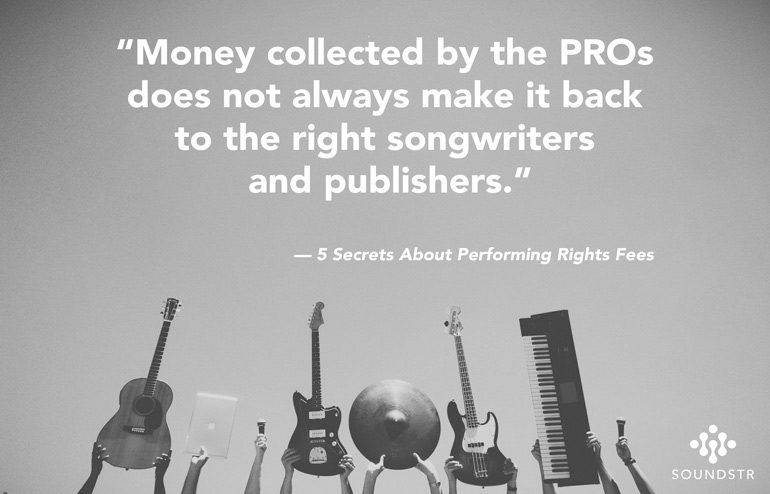[vc_row][vc_column][vc_column_text]If you had the opportunity to save money on performing rights fees for your business, would you take it? How about guaranteeing your payments went to the actual songwriters who deserve them?
It’s time to have a serious talk about the performing rights industry. What can we do to make it a more fair and transparent for businesses and songwriters? Let’s start the conversation that should have begun a long time ago.
Yes, paying performing rights fees is the right and legal thing to do. And yes, that money does go to songwriters. But the basic lack of transparency is the issue. If a business knew exactly what they are paying for and where that money goes, this conversation might not be necessary.
Most venue owners cringe when performing rights organizations (“PROs”) come up in conversation. But companies like ASCAP, BMI, SESAC and Global Music Rights (GMR) play an important role in our industry. They collect money from businesses for music use and distribute royalties to songwriters. Any business should realize the value music plays in their establishment. The focus of the conversation should not be about paying PROs. Instead, we need to talk about the fee structure and royalty distribution process. In other words, how is the money collected and where does it go?
1. General Blanket Licenses/Venue Reporting
Starting at the top, it is important to know how performing rights fees are currently structured. Regardless of your fee agreement, which is different for many businesses, you pay for a “general blanket license.” This gives you the ability to play any song within a PRO’s catalog. ASCAP and BMI’s catalogs are each over 10 million songs, with SESAC’s at around 500,000. (Global Music Rights does not disclose this info to the public, but it is smaller than SESAC’s.) Since it is impossible to play millions of songs each year in a business, you are essentially paying for something you do not use.
In the case of large concert promoters, PRO fees are deducted from touring artist ticket sales as a percentage of every ticket sold. Promoters must make deductions for each of the four US PROs, regardless of the PRO affiliation of the music performed or broadcast at a given concert. This means, artists are generally paying for music they aren’t performing.
2. Songwriter Royal Distribution
One of the main contentions raised by businesses and venue owners when licensing music is the inability of the PROs to prove the money paid goes back to the songwriters featured. This stems from the basic adage: when you do a job, you should receive compensation. The problem is that the money collected by the PROs does not always make it back to the correct songwriters and publishers. The real reason, regardless of what the PROs publish on the issue, is the lack of identification and verification. The PROs still use radio as their main proxy for determining who receives royalty distributions. Most touring songwriters never receive radio airplay. Despite paying performing rights fees at show settlement, these songwriters do not receive royalties. Based on a recent case study, only 20% of the songs on the radio were also played in a business. This means upwards of 80% of the royalties distributed went to the wrong songwriters. How is this fair?
3. Radio & TV – The Other Mediums
It is clear that there are inefficiencies when it comes to performing rights fees for businesses and venues. But what drives the knife in even further is the structure of similar mediums like radio and TV. By federal law, these mediums can obtain a “Per Segment” license, which states they only pay for actual music usage. This is due to both mediums having the ability to track and submit playlist data. Does that seem fair? Well keep reading, because I have a feeling you will like where this is going.
4. Technology is the Answer
It’s clear that the main issue is transparency, especially when comparing different mediums. But what if technology could offer a solution that could level the playing field? Well, we are happy to tell you that time has come. New technology has the ability to identify real world music use, which allows for song identification and verification. This means that a business can now generate a report to show all music performed and broadcast in their establishment. These reports show with which PRO(s) the music used is registered. This offers a business paying a blanket license the ability to negotiate license fees based on actual music use or a promoter to ensure their hosted artists aren’t being over-charged for PRO fees.
5. The Future
The performing rights industry is in the midst of serious change. The laws that structure this 100 year old industry are currently under review. This is due to both the ability of recognition technology and lobbyist groups fighting for fairness. There is an overwhelming sense of pressure to modernize the music industry altogether. Transparency would allow for more money to flow through the system. Businesses would have the ability to negotiate fairer (and potentially lower) fees. Songwriters would receive more compensation for their work. The PROs could license more businesses and would have a more positive position in the industry. It’s a win-win-win for those interested in the sustainability in this fractured business. And that’s exactly what we’re hoping for.
Click below for a FREE webinar that shows how your business or venue can start identifying your music use today.


